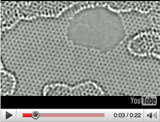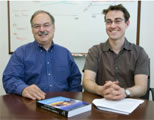


Berkeley Lab researchers have made the first ever live action movie of the dynamics of atoms. Working with TEAM 0.5, the world’s most powerful transmission electron microscope, they recorded a movie showing in real-time carbon atoms repositioning themselves around the edge of a hole punched into a graphene sheet. Their results bode well for the spintronic dreams of the electronics industry. More> This research made the cover of the most recent edition of Science magazine. ![]()
 When it comes to developing a more sustainable energy system, the U.S. record is mixed, say Berkeley Lab scientists Mark Levine (left) and Nathaniel Aden. Their analysis, published in a chapter of a new book, Agenda for a Sustainable America, shows that between 2000 and 2006 the energy and carbon intensity of gross domestic product continued its long-term decline even as GDP increased. At the same time, they add, “increased fossil fuel consumption, stagnant energy efficiency standards and expanding corn-based ethanol production have moved the energy system in the opposite direction, toward a less sustainable energy system.” More>
When it comes to developing a more sustainable energy system, the U.S. record is mixed, say Berkeley Lab scientists Mark Levine (left) and Nathaniel Aden. Their analysis, published in a chapter of a new book, Agenda for a Sustainable America, shows that between 2000 and 2006 the energy and carbon intensity of gross domestic product continued its long-term decline even as GDP increased. At the same time, they add, “increased fossil fuel consumption, stagnant energy efficiency standards and expanding corn-based ethanol production have moved the energy system in the opposite direction, toward a less sustainable energy system.” More>
 In The News: Problems in the Uranium Bioremediation Avenue Identified
In The News: Problems in the Uranium Bioremediation Avenue Identified[Physorg.com] The overall mobility of uranium in the environment is determined by its oxidation state. In its hexavalent state, uranium is usually more soluble and travels with water. But in the tetravalent state, uranium is insoluble and practically immobile. The goal for researchers is to reduce uranium and keep it stabilized in its tetravalent state. "We want to find a way to immobilize uranium in contaminated groundwater so it doesn't move around," said Berkeley Lab earth scientist Tetsu Tokunaga. "However, some of our earlier work, led by Jiamin Wan [also with Berkeley Lab], has shown that this can be problematic." More>
The overview course on non-radiological hazard orientation to Berkeley Lab (EHS0010) has been updated. Starting Wednesday, April 1, the course is required for all employees and guests, as well as those hired prior to Jan. 1, 1982. Those who have taken facility-specific orientation courses (e.g. ALS, Molecular Foundry, JBEI, and the Joint Genome Institute) must now also take the EHS0010 course, as the facility-specific training is now supplemental to EHS0010. The requirements for EHS0010 and for facility-specific orientation courses now show up on the JHA as well as the Training Profile. After January 1, 2010 an annual refresher to EHS0010 will be required, so that new information can be communicated. Contact Lara Jain for more information (x5271).
 World of Science: Latest Edition of Cal’s ‘Science Matters’ Out
World of Science: Latest Edition of Cal’s ‘Science Matters’ Out ScienceMatters@Berkeley, an online magazine produced by UC Berkeley’s College of Letters and Science, features stories on professors at the forefront of cutting-edge research and promising new discoveries. The latest issue includes stories on “The Incredible, Malleable Embryo,” “Biting into Evolution,” and “Spiky Fish Reveals Evolution's Toolkit.” More>
Today at Berkeley Lab is produced by Public Affairs' Communications Department